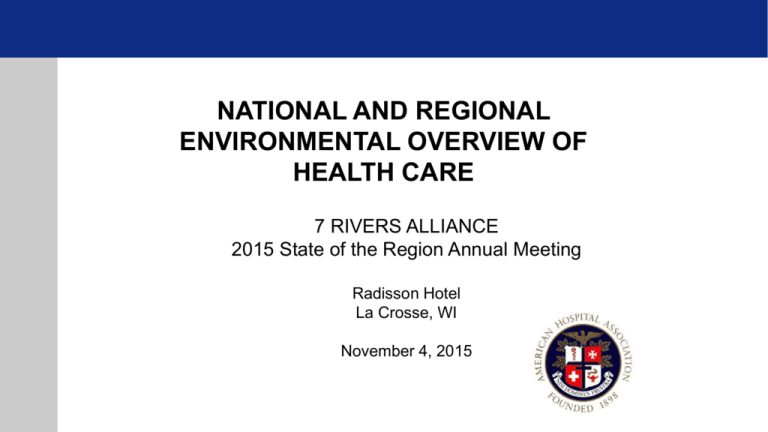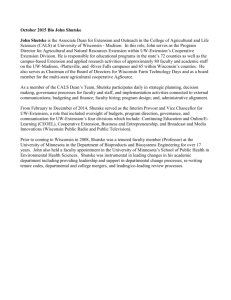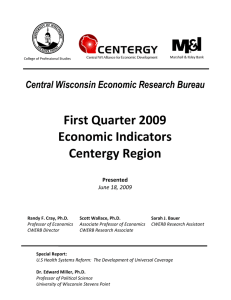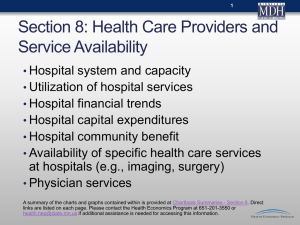national and regional environmental overview of
advertisement

NATIONAL AND REGIONAL ENVIRONMENTAL OVERVIEW OF HEALTH CARE 7 RIVERS ALLIANCE 2015 State of the Region Annual Meeting Radisson Hotel La Crosse, WI November 4, 2015 Political Landscape Reducing the federal deficit is bipartisan and both political parties are willing to reduce health care expenditures to get there—often threatening support for both Medicare and Medicaid. Results from the Commonwealth Fund’s Scorecard on State Health System Performance, 2014: Improvements in childhood immunizations, hospital readmissions, safe prescribing, and cancer deaths, but costs continue to increase with little or no improvement relative to improving access to care, reducing health disparities, and improving care coordination. Increasing diversity in the U.S. electorate: Huge impact on politics…and health care. Population Projections Reflect Slower Growth and Increasing Diversity Population Characteristics 78 M baby boomers expected to live longer (84) and with chronic conditions. Palliative care, a rapidly growing field, likely will fill many of the gaps in health care coverage in the future. Only 10–15% of an individual’s health status is attributable to the health care services received. The rest is driven by behavior, genetics and social factors – including housing, access to food, jobs, and education status. Nationally, 42.5 M adults 18 or older (18.2% of U.S. population) experienced a mental illness in the past year. Even so, in 2012, only 62.9% of adults in the U.S. with serious mental illness (6 million) received mental health in the prior 12 months. Health Care Expenditures per Capita by State of Residence, 1996-2009 $30,000 $25,000 $7,233 $6,850 $7,003 $6,540 $6,147 $20,000 $5,752 $5,408 $5,079 $4,730 $15,000 $3,375 $3,534 $10,000 $3,482 $3,335 $5,000 $3,421 $0 1996 $3,659 $3,491 $3,705 $3,957 $3,780 $4,026 $4,143 $3,991 $4,306 $4,461 $4,222 $4,860 $4,541 $5,238 $4,820 $5,609 $5,930 $6,252 $6,612 $6,978 $7,133 $7,409 Minnesota Iowa United States $5,793 $6,618 $6,921 $6,118 $6,358 $5,182 $5,445 $5,411 $5,726 $6,028 $6,318 $6,566 $6,815 2004 2005 2006 2007 2008 2009 $3,574 $3,728 $3,902 $4,127 $4,435 $4,767 $5,096 1997 1998 1999 2000 2001 2002 2003 Wisconsin Health Care Expenditures by State of Residence (in millions), 1996-2009 $38,371 $36,438 $34,067 $17,650 $16,411 $18,612 $17,428 $9,606 $10,093 1996 1997 $19,628 $19,049 $10,973 1998 $21,470 $20,193 $11,644 1999 $23,141 $22,007 $12,363 2000 $25,578 $24,215 $13,301 2001 $27,666 $26,282 $29,631 $28,329 $31,704 $30,126 $36,222 $39,410 $40,871 $38,994 $37,306 $34,040 $31,928 Iowa $14,120 2002 $15,206 2003 $16,021 2004 $17,091 2005 $18,141 2006 $18,947 2007 $19,818 2008 $20,822 Minnesota Wisconsin 2009 National Health Insurance Trends Impact of ACA: Increase of about 30% in inpatient utilization, 15% increase in ER use rates, and 40 - 70% increase in outpatient elective services. Employers are moving employee health plans from defined benefit to defined contribution structures. Exchange carriers use narrow or “ultra narrow” networks to limit access to certain “cost effective” physicians and facilities. Consequently, patients are sometimes surprised by charges from out-of-network specialists when they go to in-network hospitals. Health Insurance Coverage of the Total Population (YE 2013) 57% 55% 54% 17% 14% 13% 13% 14% 13% 9% 9% 7% 7% 5% EMPLOYER 9% OTHER PRIVATE 1% MEDICAID Iowa MEDICARE Minnesota Wisconsin 0 OTHER PUBLIC 0 UNINSURED Hospital Emergency Room Visits per 1,000 Population 1999 vs 2013 450 418 400 350 365 357 300 250 1999 Total 2013 Total 200 150 100 50 0 Iowa Minnesota Wisconsin Hospital Admissions per 1,000 Population by State of Residence, 1999-2013 400 Chart Title 350 300 105 103 100 101 111 111 108 104 125 112 111 110 106 Total Total Total Total Total 250 99 200 112 150 100 50 0 Iowa Minnesota Wisconsin Health System Transformation 86% of health care CEOs believe technological advances will transform their businesses in the next five years. Demographics will force transformation in customer growth and retention strategies. Unsustainable health care costs and an inordinate share of GDP are forcing the U.S. health care system to transform from hospital-centric sick care to a super outpatient model that will emphasize community-based care. Hospitals are increasing scale through horizontal and vertical integration and moving toward better collaboration, prioritization of programs, increasing purchasing power, consolidating services and cutting costs. Practitioners, payers, patients, and policymakers are demanding value, best outcomes, and transparency. Community Hospitals by Ownership Type, 1999 vs 2013 400 350 129 123 300 250 121 120 200 131 134 150 100 2 92 2 42 95 36 118 115 50 59 59 56 0 State/Local Government 1 0 For-Profit Non-Profit Total State/Local Government 1999 57 6 0 2 For-Profit Non-Profit 2013 Iowa Minnesota Wisconsin Total Physicians With SGR reform, physician payment shifts by 2019 from payment for volume to value. Consequently, physicians will need capital resources and infrastructure to capture cost, quality, and outcome data or work with an entity that can provide it. Therefore, physicians are like to: • Retire earlier; • Move into mega groups; or • Become employed by hospitals/health systems or insurers. As physicians become employed, certain issues need to be addressed: Trust, loss of autonomy, loss of referral networks, loss of connections and collegiality with specialists, and concerns about hospitals not providing support for improving quality. Health Care Workforce Increased hospital CEO turnover: Increased in 2013 to 20% vs 14 – 18% in early 2000. 53% of CEOs want to hire, but 63% are concerned about finding qualified people. Private-sector health care employment was essentially flat falling by 400 jobs (Bureau of Labor Statistics Employment Situation Summary, February 2014) compared to previous 24-month average gain of 18,500 jobs. • Hospitals lost 4,500 jobs compared to previous the 24-month average gain of 1,100. • Ambulatory care added 9,000, but well below the 24-month average gain of 14,800. • Nursing and residential care facilities lost 4,900 jobs – well below the 24-month average gain of 2,600 jobs. Information and Technology Although expensive, IT will be the major platform or strategy for advancing Health care organizations in the new payment and delivery world. Care coordination of patients with chronic and complex health conditions who see multiple physicians can be supported by better IT. Yet, security, access, and interoperability issues across electronic health record systems remain substantial barriers. Disruptive technologies such as satellites, drones, smart phones, and webbased services will force adaption and innovation by all parties in health care. Patient Safety and Quality Medicare readmission rates have declined since 2011 to less than 18% leading to approximately 130,000 fewer hospital readmissions between January 2012 and August 2013. Palliative care and end of life care are being discussed, but no real “political will” to develop meaningful national policy ACA Leading to Lower Hospital Readmission Rates for Medicare Beneficiaries (CMS) NATIONAL AND REGIONAL ENVIRONMENTAL OVERVIEW OF HEALTH CARE Kim Byas, Sr., PhD, MPH, FACHE Regional Executive American Hospital Association Chicago IL 312-422-2885 kbyas@aha.org

![Associate director meeting notes Septemb[...]](http://s3.studylib.net/store/data/006743469_1-274aca726a0c2a3aa4cf5a4cd4d8cad8-300x300.png)






